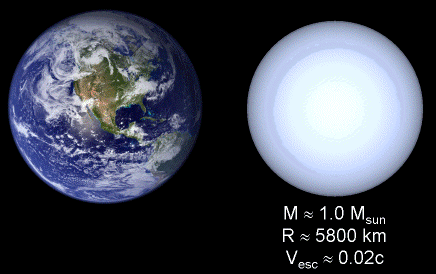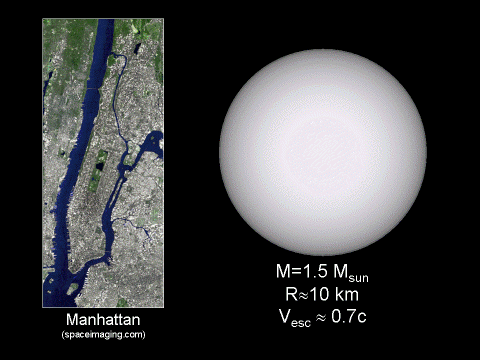

|
Astronomy 162:
Introduction to Stars, Galaxies, & the Universe
Prof. Richard Pogge, MTWThF 9:30
|
Lecture 19: Extreme Stars
White Dwarfs & Neutron Stars
Readings: Readings: Ch 22, section 22-4; Ch 23,
sections 22-1 thru 5
- White Dwarfs:
- Remnants of low-mass stars
- Supported by Electron Degeneracy Pressure
- Maximum Mass ~1.4 Msun (Chandrasekhar Mass)
- Neutron Stars:
- Remnants of some post-supernova massive stars
- Supported by Neutron Degeneracy Pressure
- Pulsar = rapidly spinning magnetized neutron star
The Stellar Graveyard
Question:
- What happens to the cores of dead stars?
Answer:
They continue to collapse until either:
- A new pressure law takes hold to halt further collapse &
they settle into a new hydrostatic equilibrium.
- If too massive they collapse to zero radius and become a
Black Hole.
All of these are seen as the remnants of stellar evolution.
Degenerate Gas Law
At high density, a new gas law takes over:
- Pack many electrons into a tiny volume
- These electrons fill all low-energy states
- Only high-energy = high-pressure states left
Result is a "Degenerate Gas":
- Pressure is independent of Temperature.
- Compression does not lead to heating.
This means that the objects could, in principle, be very cold but
still have enough pressure to maintain a state of Hydrostatic Equilibrium.
Can such objects exist?
These are the remnant cores of stars with M < 8 Msun.
- Supported against gravity by Electron Degeneracy Pressure
- M<4 Msun: C-O White Dwarfs
- M = 4-8 Msun: O-Ne-Mg White Dwarfs
Properties:
- Mass < 1.4 Msun
- Radius ~ Rearth (<0.02 Rsun)
- Density ~ 105-6 g/cc
- Escape Speed: 0.02 c (2% speed of light)
No nuclear fusion or gravitational contraction. It shines by
residual heat.

- Comparison of a White Dwarf Star and the Earth.
Chandrasekhar Mass
Mass-Radius Relation for White Dwarfs:
- Larger Mass = Smaller Radius
Chadrasekhar Mass:
- Maximum Mass for White Dwarf: Mch = 1.4 Msun
- First calculated by Subrahmanyan Chandrasekhar in the 1930s.
- Above this mass, electron degeneracy pressure fails
& the star collapses.
This prediction of a maximum white dwarf mass is upheld by observations.
So far, all white dwarfs we have seen in binary stars have masses below
the Chandrasekhar Mass.
Evolution of White Dwarfs
White dwarfs shine by leftover heat.
- No energy source (no fusion, nothing)
- Cools off and fades away slowly.
- Forms a White Dwarf Cooling Sequence on the H-R diagram
Ultimate State: A "Black Dwarf":
- Old, cold white dwarf
- Takes ~10 Tyr to cool off
- Galaxy is not old enough for there to be any Black Dwarfs yet.
Note: Be careful not to confuse Black Dwarfs (old, cold remnant
cores of low-mass stars) with "Black Holes" (the extremely collapsed
cores of very massive stars).
White Dwarfs: The Other Supernovae
- Question:
- What would happen if you added enough matter to a White Dwarf to
exceed its Chandrasekhar Mass?
Above the Chandrasekhar Mass, the internal electron degeneracy pressure
is no longer able to balance Gravity, and it will begin to collapse...
- As the density rises, the temperature does not increase
- Eventually ignites carbon-oxygen burning at high enough density
- This begins to generate heat, but no additional pressure to slow
the collapse
- The extra heat leads to greater fusion, which leads to greater heat...
The effect is a runaway nuclear explosion:
- Fusion of the light elements into Iron and Nickel
- The white dwarf detonates and disrupts completely as a
Type Ia Supernova.
Type Ia Supernovae leave no remnant behind, and may be responsible
for the production of much of the Iron in the Universe.
Remnant cores of massive stars:
- 8 < M* < 18 Msun (??)
- Leftover core of a core-bounce supernova
Held up by Neutron Degeneracy Pressure:
- Mass ~1.2 - 2 Msun (???)
- Radius ~10 km
- Density ~1014 g/cc
- Escape Speed: 0.70 c (70% speed of light)
No nuclear fusion or gravitational contraction. It shines by
residual heat.

- Comparison of a Neutron Star and the Island of Manhattan.
Structure of a Neutron Star
At densities > 2x1014 g/cc:
- nuclei melt into a sea of subatomic particles.
- protons & electrons combine into neutrons.
Surface is cooler, forming a solid crystalline crust!
Inside is exotic matter: superfluid neutrons, superconducting
protons, and stranger subatomic particle matter:
Inside a Neutron Star

Accidental Discovery
- 1967:
- Jocelyn Bell (Cambridge grad student) &
Anthony Hewish (her adviser) discover rapidly pulsating radio
sources while looking for something else.
They called these new, otherwise unknown objects
"Pulsars" = Pulsating Radio Sources
Pulsars emitted sharp, 1 millisecond-long pulses every second at an
extremely repeatable rate (most accurate clocks known at the time).
Anthony Hewish shared the 1974 Nobel Prize for Physics for his role in the
discovery of pulsars. Jocelyn Bell, however, did not.
Pulsars
- Rapidly spinning, magnetized neutron stars.
Lighthouse Model:
- Spinning magnetic field generates a strong electric field.
- Electric field rips electrons of the surface and accelerates
them along the magnetic poles.
Result:
- Twin beams of radiation shining out of the magnetic poles:

If the magentic axis is mis-aligned with the rotation axis of
the neutron star (as shown), the star's rotation sweeps the beams over us
as it rotates, and we will see regular, sharp pulses of light (optical,
radio, X-ray, etc.)
Pulsar Evolution
Pulsars spin slower as they age.
Young neutron stars:
- fast spinning pulsars.
- found in supernova remnants (e.g., Crab pulsar)
Old neutron stars: cold and hard to find.
[But some neutron stars that are not also pulsars have been finally
seen. Hubble
Space Telescope detection of a lone neutron star.]
Over the Top?
What if the remnant core is very massive?
- "Very Massive" = Mcore > 2-3 Msun
(original star would have had a mass M > 18 Msun)
- Neutron degeneracy pressure fails.
- Nothing can stop the gravitational collapse.
- Collapses to zero radius and infinite density.
The core becomes a Black Hole.
We will meet these exotic objects in the next lecture.
Return to [
Unit 3 Index
|
Astronomy 162 Main Page
]
Updated: 2006 January 30
Copyright © Richard W. Pogge, All Rights Reserved.




